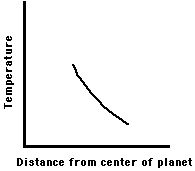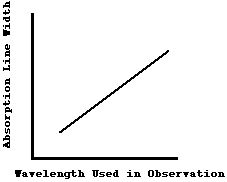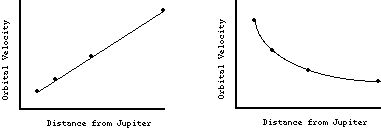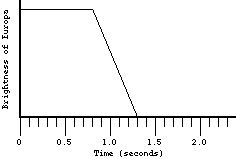PPPP - Jupiter system
Since Jupiter has an internal heat source, the temperature profile of its atmosphere shows that it is generally cooler the further away one looks from the center of the planet. Saturn also has an internal heat source and similar composition, but its appearance is markedly different.
a) (6 pts) Explain how Jupiter generates its own heat.
b) (6 pts) Why does Jupiter show more prominent colored bands relative to Saturn?
--
Since Jupiter/Saturn has an internal heat source, the temperature profile of its atmosphere shows that it is generally cooler the further away one looks from the center of the planet. Bands on Jupiter are regions of high pressure (dark bands, deeper in the atmosphere) and low pressure (light bands, higher up in the atmosphere).
a) (4 pts) Which color bands would you expect to have broader lines? (dark, light, same width, can’t determine)?
b) (8 pts) Explain your answer to part (a).
--
The two largest giant planets, Jupiter and Saturn, have their own internal heat sources. Describe them.
--
Suppose a gaseous planet has a temperature profile in its atmosphere as shown below.
a) (4 pts) The source of this planet’s heat is (internal/external/can’t determine).
b) (8 pts) Explain your answer to part (a).

--
It is well known that Jupiter has an internal heat source. Its atmosphere is about 99% Hydrogen and Helium, the lightest elements known to exist. Despite this, Jupiter has several bands in its atmosphere with coloring caused by the presence of methane (CH4), a heavier trace constituent of its atmosphere. Since methane is so much heavier than Hydrogen and Helium, it seems that differentiation should have forced all the methane to the bottom layers of the atmosphere rather than the visible top layers. Why, then, is methane visible at all?
--
Explain why we think Jupiter is larger than Saturn.
--
The graph below is a measure of absorption line width in the atmosphere vs wavelength used in observation for a certain planet. According to the graph, as you observe with longer wavelengths, absorption lines seen in the atmosphere appear broader.
a) (2 pts) This planet’s heat source is (internal/external/can’t determine).
b) (6 pts) Explain your answer to part (a).

--
Jupiter is about 300 times more massive than the Earth, but the strength of its magnetic field indicates that it has a much higher fraction of metallic material in its interior than the Earth. On the other hand, Saturn’s overall composition is identical to that of Jupiter (for our purposes), but it doesn’t show any signs of a high fraction of metallic material. Explain this difference.
--
Jupiter has a very rapid rotation rate and an extremely strong magnetic field.
a) (4 pts) Besides fast rotation, what other property must a planet have in order for it to generate a strong magnetic field?
b) (8 pts) Jupiter is composed of about 90% Hydrogen. Explain why this gas helps Jupiter generate a strong magnetic field.
--
Jupiter and its volcanically active moon Io are both actually emitting more energy than they absorb from sunlight.
a) (6 pts) Explain the source of internal heat on Jupiter.
b) (6 pts) Explain the source of internal heat on Io.
--
We know that Jupiter has an internal heat source because when we look at the planet with longer and longer wavelengths, the width of the spectral lines in Jupiter’s spectrum get broader and broader.
a) (4 pts) Explain why temperature and spectral line width are related in this way.
b) (4 pts) Explain why longer wavelengths probe deeper into Jupiter’s atmosphere.
--
The origin of Jupiter's satellite system is not explained well by the fission hypothesis but rather by a kind of Co-Accretion process.
a) (4 pts) State in a simple sentence or two why the composition of Jupiter's moons argues against the fission hypothesis for their origin.
b) (10 pts) Explain how the Co-Accretion theory correctly explains both the sizes and varying densities of Jupiter's moons.
--
Below are two possible rotation curves to represent the four major moons around Jupiter. Which of the two rotation curves should accurately reflect the real situation around Jupiter (choose left or right)? Explain your answer.

--
We can use cratering patterns to determine the relative ages of the maria and the highlands on Earth’s moon. We can use a similar technique on Ganymede, though it doesn’t involve impact craters, because Ganymede’s surface is divided into distinct “dark” and “light” regions (ignoring the presence of the bright craters).
a) (4 pts) Which type of surface on Ganymede is younger (dark or light)?
b) (8 pts) Explain your answer to part (a).
--
So far, we’ve studied three objects in the solar system that have had volcanic eruptions on their surfaces within the very recent past (Venus, Earth and Io).
a) (6 pts) Of the three, only Io has a trail of volcanic debris surrounding it. Why is it so different from Earth and Venus, which have no such trail?
b) (6 pts) Io’s trail of debris is actually swept out in front of Io as it orbits Jupiter. Describe the mechanism that causes this.
--
Jupiter’s four major moons, listed from closest to furthest from the planet, are Io, Europa, Ganymede and Callisto.
a) (3 pts) What is the primary reason that Io is so much denser than Callisto?
b) (3 pts) What is the primary reason that Io is so much smaller than Callisto?
--
The equation for the orbital velocity of a planet’s moon is given on the cover page.
a) (6 pts) Suppose Jupiter’s moon, Io, is instead orbiting Saturn, a planet with one-third the mass of Jupiter, at the same distance (r) as it previously orbited about Jupiter. Does Io move (faster/slower/same speed/can’t determine)? Explain.
b) (6 pts) Suppose Io were moved from its present location around Jupiter to a distance twice as far away from Jupiter. Does Io now move (faster/slower/same speed/can’t determine)? Explain.
--
Like Ganymede and Callisto, Europa’s surface is composed of water-ice. Europa’s interior, however, is rocky. Because of this, state how Europa’s overall density compares to that of Ganymede and Callisto (i.e. Europa is more dense/less dense/same density/can’t determine). Explain your answer.
--
Impact craters on the surface of a planet or a moon can tell us a lot about that history of that object and its geology.
a) (6 pts) Why does Io have relatively few impact craters? Explain.
b) (6 pts) Explain the two heat sources that drive Io’s geological activity.
--
A typical occultation of Jupiter’s moon, Europa, lasts about 3 minutes from the time it begins to pass behind Jupiter until it completely vanishes. Using your knowledge of the equation of orbital velocity , suppose Jupiter were only one-fourth as massive as it is today.
a) (4 pts) The occultation of Europa would take (more/less/same/can’t determine) time in this case.
b) (8 pts) Explain your answer to part (a). You may want to use some equations.
--
Explain why the Galilean satellites (Io, Europa, Ganymede, Callisto) of Jupiter have varying compositions while the moons of Saturn are uniformly icy. As part of your answer, describe how the process of fractionation works.
--
Although Europa’s surface is composed of smooth, virtually crater-free ice, we know that Europa’s interior is largely composed of rock.
a) (6 pts) Explain how we know about the rocky interior even though we cannot actually see inside the planet.
b) (6 pts) What direct evidence leads us to believe that there is actually liquid water a very short distance below the surface of Europa (I’m not asking you to describe the heating mechanism that makes the existence of this liquid water possible...I’m asking how we know the water must be there beneath the surface)?
--
Suppose you’re an Astronomer, and you’ve decided to find out the diameter of Jupiter’s moon Europa. To do this, you construct a light curve showing Europa’s brightness as it is gradually eclipsed by Jupiter. Assume for this problem that Europa is moving at a speed relative to Jupiter of 8,000 miles per second. Given the light curve below, estimate the diameter of Europa in miles and explain your calculation.

--
One theory that tries to explain the varying sizes of Jupiter’s four major satellites is called the “infall theory”. This theory states that the reason Jupiter’s innermost moon, Io, is so small is that it suffers from more frequent, more powerful impacts (that presumably chip away at its total size over time) than Jupiter’s outermost satellite, Callisto. Explain why meteorite impacts on Io would be expected to be more powerful than meteorite impacts on Callisto (this is a similar concept to the thought question about asteroidal and cometary particles).
--
The origin of Jupiter's satellite system is not explained well by the fission hypothesis but rather by a kind of Co-Accretion process.
a) (4 pts) State in a simple sentence or two why the composition of Jupiter's moons argues against the fission hypothesis for their origin.
b) (10 pts) Explain how the Co-Accretion theory correctly explains both the sizes and varying densities of Jupiter's moons.
--
Recently, the Galileo spacecraft has made new discoveries about three of Jupiter's major moons.
a) (7 pts) Europa and Ganymede both have extremely thin Oxygen atmospheres. How are these atmospheres sustained over time (considering that both have such low escape velocities that Oxygen easily escapes after a short time)? In other words, how is Oxygen added to the atmosphere to replace the lost Oxygen that escapes?
b) (7 pts) Callisto doesn't seem to be geologically active enough to support a magnetic field in the traditional (molten rock) sense, yet it does have a weak magnetic field. What do Astronomers think is the source of this weak magnetic field?
--
Although none of the four large moons of Jupiter (Io, Europa, Ganymede, Callisto) has a significant atmosphere, there is enough activity on each of the moons to cause some atoms to be released from the surface, similar in some respects to the outgassing that presumably contributed to the atmospheres of the terrestrial planets.
a) (8 pts) Describe the heat source that forces Jupiter's innermost moon Io to emit ionized gas from its surface. ALSO ANSWER: Why does this gas get swept up into a tail preceding Io as it orbits Jupiter?
b) (6 pts) Describe the source of the very thin Oxygen atmosphere on Ganymede.
--
The fact that Jupiter was able to accumulate massive amounts of Hydrogen gas during the planetary formation phase of our solar system helped make Jupiter much larger and more massive than the Earth.
a) (6 pts) Though the Earth was unable to hold onto Hydrogen, it was able to capture and hold more massive gases like Carbon Dioxide. Explain why (note that merely stating a relationship between mass and velcity is not sufficient...it must be explained).
b) (8 pts) Name and briefly explain two reasons why Jupiter was able to capture and hold onto Hydrogen gas while the Earth was not able to.
--
When the Voyager spacecraft flew past Jupiter, it discovered a faint ring system. It turns out that all four of the outer planets have ring systems. What is the origin of the ring material that makes up Jupiter's faint ring? Just state it, no explanation needed.
--
Name and explain two reasons why Jupiter can attract and hold Hydrogen gas while the Earth cannot. As part of your answer, explain the relationship between gas mass and gas velocity (why does this relationship exist?).
--
Of Jupiter's four largest satellites, the most interesting in terms of prospects for life is Europa.
a) (7 pts) Explain why we think Europa may contain life. As part of your answer, briefly describe the heat source that keeps conditions suitable there.
b) (7 pts) Europa has recently been shown to have a very thin Oxygen atmosphere, too thin for life, but detectable nevertheless. Where did this atmosphere come from? Explain.
--
Explain what we have concluded about Jupiter's formation thanks to measurements of Argon in its atmosphere (describe what was found and one possible explanation for the measurements).
--
Jupiter’s moon, Io, is an example of a moon that formed under conditions of high temperature, so it is almost pure rock, with a density of about 4 grams per cubic centimeter. Another moon in the solar system, called “X”, has twice the mass and twice the size of Io.
a) (4 pts) Show mathematically how the density of “X” compares to Io.
b) (4 pts) Explain how the formation conditions of “X” must be different than Io.
--
In addition to their strange surface pattern of colored bands, two of the outer planets (Jupiter and Saturn) are actually emitting more energy than they are absorbing from sunlight.
a) (6 pts) Explain the source of the colored bands on Jupiter.
b) (6 pts) Explain the source of internal heat on Saturn.



